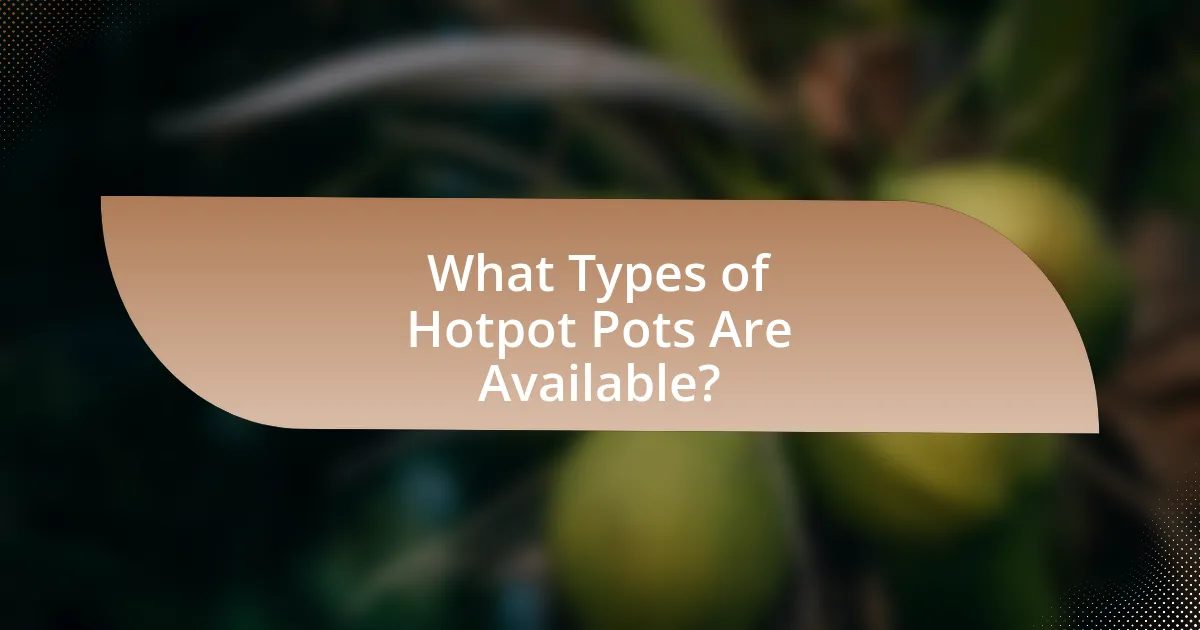Choosing the right pot for hotpot is essential for an enjoyable dining experience, and several factors must be considered, including material, size, and heat conductivity. The article outlines the impact of pot size on cooking time and ingredient variety, recommending specific sizes for different group sizes. It also compares materials such as stainless steel, cast iron, and ceramic, highlighting their advantages and disadvantages. Additionally, the article discusses the importance of pot shape, the benefits of divided pots, and the functionality of electric hotpot pots, providing insights into maintenance and best practices for optimal cooking results.

What Factors Should You Consider When Choosing a Pot for Hotpot?
When choosing a pot for hotpot, consider material, size, and heat conductivity. The material affects durability and heat retention; stainless steel and cast iron are popular for their excellent heat distribution. Size is crucial for accommodating the number of diners and the volume of ingredients; a larger pot is suitable for gatherings, while a smaller pot works for intimate meals. Heat conductivity ensures that the pot heats evenly, which is essential for cooking ingredients thoroughly. For instance, copper pots offer superior conductivity but may require more maintenance.
How does the size of the pot impact your hotpot experience?
The size of the pot significantly impacts your hotpot experience by determining the amount of broth and ingredients that can be cooked simultaneously. A larger pot allows for more ingredients, enhancing the variety and quantity of food available, which can lead to a more satisfying meal. Conversely, a smaller pot may limit the selection and quantity, potentially diminishing the overall enjoyment. Research indicates that a pot size of at least 3-4 liters is optimal for a group of 4-6 people, ensuring ample space for cooking and sharing, which is a key aspect of the hotpot dining experience.
What are the ideal sizes for different group sizes?
The ideal pot sizes for different group sizes are as follows: for 1-2 people, a pot size of 1-2 liters is recommended; for 3-4 people, a pot size of 3-4 liters is suitable; for 5-6 people, a pot size of 5-6 liters is ideal; and for 7-8 people, a pot size of 7-8 liters is appropriate. These sizes ensure that there is enough space for ingredients and broth while allowing for even cooking and easy access. The recommendations are based on standard serving sizes and cooking practices in hotpot dining, which typically involves sharing a communal pot.
How does pot size affect cooking time and heat distribution?
Pot size significantly affects cooking time and heat distribution, with larger pots generally requiring more time to heat up and distribute heat evenly compared to smaller pots. This is because a larger volume of food or liquid takes longer to reach the desired temperature, leading to extended cooking times. Additionally, heat distribution in larger pots can be less uniform, as the heat may not penetrate as deeply or evenly, potentially resulting in unevenly cooked food. Conversely, smaller pots heat up quickly and provide more consistent heat distribution, making them ideal for rapid cooking and ensuring that all ingredients are cooked uniformly.
What materials are best for hotpot pots?
The best materials for hotpot pots are stainless steel, cast iron, and ceramic. Stainless steel is favored for its durability and resistance to rust, making it easy to clean and maintain. Cast iron retains heat well, providing even cooking temperatures, while ceramic offers excellent heat retention and aesthetic appeal. These materials are commonly used in hotpot pots due to their ability to withstand high temperatures and their effectiveness in cooking various ingredients evenly.
What are the advantages and disadvantages of stainless steel pots?
Stainless steel pots offer durability and resistance to rust and corrosion, making them a popular choice for cooking. Their non-reactive nature ensures that they do not alter the taste of food, which is particularly beneficial for hotpot dishes that require a variety of ingredients. Additionally, stainless steel pots are easy to clean and maintain, often being dishwasher safe.
However, stainless steel pots have disadvantages, including poor heat conductivity compared to materials like copper or aluminum, which can lead to uneven cooking. They can also be more expensive than other pot materials, and if not properly cared for, they may develop scratches or discoloration over time.
How do ceramic and clay pots compare for hotpot use?
Ceramic pots are generally better for hotpot use than clay pots due to their ability to retain heat and distribute it evenly. Ceramic materials can withstand high temperatures without cracking, making them suitable for prolonged cooking sessions typical in hotpot meals. In contrast, clay pots, while excellent for slow cooking and flavor enhancement, may not handle rapid temperature changes as effectively, leading to potential cracking or breakage. Additionally, ceramic pots often have a smoother surface that is easier to clean, which is beneficial for maintaining hygiene during hotpot use.
Why is the shape of the pot important for hotpot cooking?
The shape of the pot is crucial for hotpot cooking because it influences heat distribution and ingredient placement. A wider, shallow pot allows for even cooking and easier access to ingredients, while a deeper pot retains heat better and can accommodate more broth. Studies show that the optimal shape enhances the cooking experience by ensuring that all ingredients are cooked uniformly, which is essential for flavor and texture.
What are the benefits of using a divided pot?
Using a divided pot allows for the simultaneous cooking of different broths or ingredients, enhancing the hotpot experience. This feature enables diners to cater to varying taste preferences, such as spicy and mild broths, within the same cooking vessel. Additionally, a divided pot minimizes cross-contamination of flavors, ensuring that each broth maintains its distinct taste. This versatility is particularly beneficial in group settings, where individual dietary restrictions or preferences can be accommodated, making the dining experience more enjoyable for everyone involved.
How does pot shape influence the cooking process?
Pot shape significantly influences the cooking process by affecting heat distribution and food interaction. For instance, a wide, shallow pot allows for quicker evaporation and browning, enhancing flavors, while a tall, narrow pot retains moisture and is ideal for steaming. Research indicates that the surface area of the pot directly impacts cooking efficiency; a study published in the Journal of Culinary Science & Technology found that pots with larger diameters cook food more evenly due to increased heat exposure. Therefore, selecting the appropriate pot shape is crucial for optimizing cooking results in hotpot experiences.

What Types of Hotpot Pots Are Available?
There are several types of hotpot pots available, including traditional metal pots, ceramic pots, electric hotpot pots, and divided pots. Traditional metal pots, often made of stainless steel or cast iron, are durable and heat evenly, making them popular for authentic hotpot experiences. Ceramic pots provide excellent heat retention and are aesthetically pleasing, suitable for serving directly at the table. Electric hotpot pots offer convenience with adjustable temperature settings, allowing for easy cooking without a stove. Divided pots feature separate compartments, enabling diners to enjoy different broths simultaneously. Each type serves specific needs and preferences, enhancing the overall hotpot experience.
What are the different styles of hotpot pots?
The different styles of hotpot pots include traditional Chinese clay pots, stainless steel pots, and electric hotpot pots. Traditional clay pots are favored for their ability to retain heat and enhance flavor, while stainless steel pots are durable and easy to clean, making them popular for modern hotpot experiences. Electric hotpot pots offer convenience with adjustable temperature settings and built-in heating elements, catering to those who prefer a more controlled cooking environment. Each style serves distinct preferences and cooking methods, ensuring a versatile hotpot experience.
How do traditional hotpot pots differ from modern designs?
Traditional hotpot pots are typically made from materials like clay or cast iron, while modern designs often utilize stainless steel or non-stick coatings. Traditional pots emphasize heat retention and even cooking, which is essential for the slow simmering process of hotpot, whereas modern designs focus on convenience, ease of cleaning, and versatility, often featuring multiple compartments for different broths. Additionally, traditional pots may have a more rustic aesthetic, reflecting cultural heritage, while modern designs often incorporate sleek, contemporary styles that appeal to current consumer preferences.
What unique features do specialty hotpot pots offer?
Specialty hotpot pots offer features such as divided compartments for cooking multiple broths simultaneously, temperature control settings for precise cooking, and materials designed for even heat distribution. These pots often include built-in strainers or lids to enhance the cooking experience and maintain flavor integrity. For instance, the divided compartments allow diners to enjoy different flavors without mixing, catering to diverse preferences in a single meal. Additionally, temperature control ensures that delicate ingredients are cooked perfectly, while materials like stainless steel or clay provide durability and optimal heat retention.
How do electric hotpot pots work?
Electric hotpot pots work by using an electric heating element to heat a pot filled with broth or water, allowing users to cook various ingredients directly at the table. The heating element is typically located at the base of the pot and is controlled by a thermostat that regulates the temperature, ensuring the broth reaches the desired cooking level. This method provides a convenient and efficient way to enjoy hotpot meals, as it allows for real-time cooking and customization of flavors.
What are the benefits of using an electric hotpot pot?
The benefits of using an electric hotpot pot include convenience, temperature control, and safety. Electric hotpot pots allow for precise temperature settings, enabling users to cook ingredients evenly and efficiently. This feature enhances the overall dining experience by ensuring that food is cooked to the desired doneness. Additionally, electric hotpot pots often come with built-in safety features such as automatic shut-off mechanisms, reducing the risk of overheating or accidents. These advantages make electric hotpot pots a popular choice for both casual and formal dining settings.
How do you choose the right electric hotpot pot for your needs?
To choose the right electric hotpot pot for your needs, consider the pot’s size, material, and features. A larger pot accommodates more ingredients and serves more people, while a smaller pot is suitable for individual use or small gatherings. Materials like stainless steel or non-stick coatings affect heat distribution and ease of cleaning. Additionally, features such as adjustable temperature settings and built-in safety mechanisms enhance usability and safety. For instance, a pot with a capacity of 4-6 liters is ideal for family meals, while a 1-2 liter pot works well for personal use.

How Can You Ensure the Best Hotpot Experience with Your Chosen Pot?
To ensure the best hotpot experience with your chosen pot, select a pot that retains heat effectively and has a suitable size for your gathering. A pot made from materials like stainless steel or cast iron provides excellent heat retention, which is crucial for maintaining the desired cooking temperature throughout the meal. Additionally, a pot with a capacity that accommodates the number of diners ensures that everyone can enjoy the hotpot without overcrowding, which can lead to uneven cooking. Research indicates that the right pot size and material significantly enhance the cooking process and overall enjoyment of hotpot, as they allow for optimal heat distribution and cooking efficiency.
What are some tips for maintaining your hotpot pot?
To maintain your hotpot pot, regularly clean it after each use to prevent food residue buildup. Use warm soapy water and a soft sponge to avoid scratching the surface, ensuring the pot remains in good condition. Additionally, avoid using metal utensils that can damage the pot’s coating; instead, opt for wooden or silicone utensils. Proper drying is essential; always dry the pot thoroughly to prevent rust, especially if it is made of cast iron or carbon steel. Lastly, store the pot in a dry place to avoid moisture accumulation, which can lead to corrosion.
How do you properly clean and store your hotpot pot?
To properly clean and store your hotpot pot, first, wash it with warm soapy water using a non-abrasive sponge to remove food residues and grease. After rinsing thoroughly, dry the pot completely with a soft cloth to prevent rust or corrosion. For storage, place the pot in a cool, dry area, ideally with a protective cover or cloth to avoid scratches and dust accumulation. This method ensures the longevity and cleanliness of the pot, as proper maintenance prevents damage and maintains hygiene.
What common mistakes should you avoid when using a hotpot pot?
Common mistakes to avoid when using a hotpot pot include overcrowding the pot, which can lead to uneven cooking and a less enjoyable experience. Additionally, not preheating the broth properly can result in undercooked ingredients, as the cooking process relies on the broth reaching the right temperature. Failing to separate raw and cooked ingredients can also pose food safety risks, as cross-contamination may occur. Lastly, neglecting to monitor the cooking time for different ingredients can lead to overcooking or undercooking, affecting the overall taste and texture of the meal.
What are the best practices for cooking with your hotpot pot?
The best practices for cooking with your hotpot pot include ensuring the pot is properly preheated, using high-quality broth, and maintaining a balanced ingredient ratio. Preheating the pot allows for even cooking and enhances flavor extraction from the broth. High-quality broth, whether homemade or store-bought, significantly impacts the overall taste of the hotpot. Maintaining a balanced ratio of proteins, vegetables, and noodles ensures that all ingredients cook evenly and absorb the broth’s flavors, leading to a more enjoyable dining experience.
How do you layer ingredients for optimal flavor?
To layer ingredients for optimal flavor in hotpot, start with the base ingredients, such as broth and aromatics, followed by proteins, and finish with vegetables and noodles. This method ensures that the flavors meld effectively; the broth infuses the proteins with taste, while the vegetables absorb the essence of the broth. Research indicates that layering ingredients in this manner enhances the overall flavor profile, as the cooking process allows each layer to contribute its unique taste to the dish.
What cooking techniques work best with different pot materials?
Different pot materials are suited for specific cooking techniques due to their unique properties. For instance, stainless steel pots are ideal for boiling and simmering because they conduct heat evenly and resist staining. Cast iron pots excel in slow cooking and braising, as they retain heat well and provide excellent heat distribution, making them perfect for stews and casseroles. Non-stick pots are best for sautéing and frying, as their surface prevents food from sticking, allowing for easy cooking and cleanup. Copper pots are highly effective for precise temperature control, making them suitable for delicate tasks like making sauces or candy. Each material’s thermal conductivity and heat retention capabilities dictate its best use in cooking techniques.
How can you troubleshoot common issues with hotpot pots?
To troubleshoot common issues with hotpot pots, first identify the specific problem, such as uneven heating, leaks, or difficulty in cleaning. For uneven heating, ensure that the pot is compatible with your heat source and check for any obstructions that may affect heat distribution. If there are leaks, inspect the pot for cracks or damaged seals, and replace it if necessary. For cleaning difficulties, use appropriate cleaning agents and techniques suitable for the pot’s material, such as non-abrasive sponges for non-stick surfaces. These troubleshooting steps are effective as they address the most frequent issues encountered with hotpot pots, ensuring a better cooking experience.
What should you do if your pot is not heating evenly?
If your pot is not heating evenly, you should first check the heat source to ensure it is functioning properly and providing consistent heat. Uneven heating can occur due to an incompatible pot material or design; for example, pots made from materials like aluminum may not distribute heat evenly compared to those made from stainless steel or cast iron. Additionally, ensure that the pot is placed correctly on the heat source, as improper placement can lead to hot spots. If the pot is warped or damaged, replacing it with a high-quality pot designed for even heat distribution is advisable.
How can you prevent food from sticking to the pot?
To prevent food from sticking to the pot, use a non-stick pot or properly season a cast iron pot. Non-stick pots are designed with a coating that reduces friction, making it difficult for food to adhere. For cast iron pots, seasoning involves applying oil and heating the pot to create a natural non-stick surface. Studies show that well-seasoned cast iron can significantly reduce sticking, as the oil fills the microscopic pores in the metal, creating a smoother cooking surface. Additionally, preheating the pot and using adequate oil or fat can further minimize sticking, as these practices create a barrier between the food and the pot’s surface.










